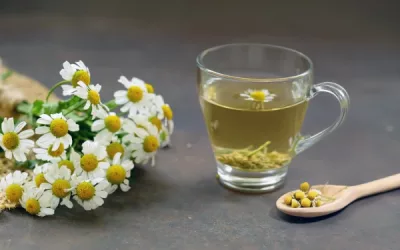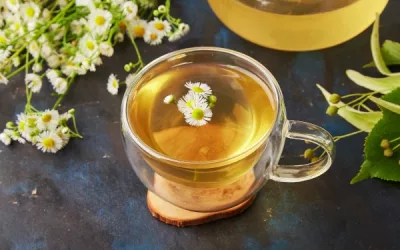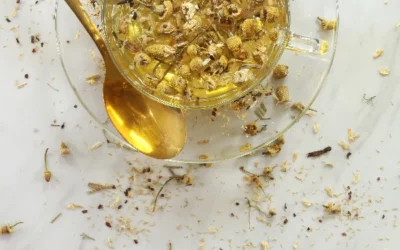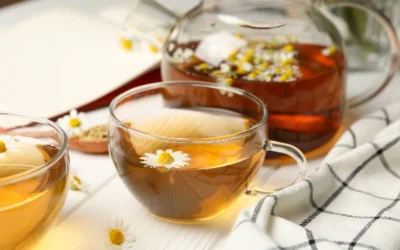Have you ever wondered why a simple cup of chamomile tea does more than just quench your thirst? This gentle brew, cherished for its floral aroma and apple-like notes, offers a taste experience that intrigues both casual drinkers and tea enthusiasts alike. Understanding the taste profile of chamomile tea is essential, not just for enjoying its rich flavours but also for appreciating its myriad health benefits. In this guide, we’ll delve into the nuances of chamomile tea, from its flavour characteristics to its preparation methods, helping you savour every sip.
Table of Content
- What is the flavour profile of chamomile tea?
- What does chamomile tea taste like?
- What are the different varieties of chamomile tea?
- How does the preparation method affect the taste of chamomile tea?
- What are common misconceptions about chamomile tea?
- Can chamomile tea be mixed with other ingredients?
- What is the best time to drink chamomile tea?
- Conclusion
What is the flavour profile of chamomile tea?
Chamomile tea has a distinctive and soothing flavour profile that makes it quite popular among tea enthusiasts and those seeking relaxation. When you brew a cup of chamomile tea, you’ll notice its light, slightly sweet taste with floral and fruity undertones.
It’s often described as having an apple-like flavour, which can be quite refreshing. The combination of these delicate flavours creates a smooth and silky mouthfeel, adding to its calming effects.
Its gentle taste is one reason why many enjoy chamomile tea as part of their nightly routine. The tea’s mild sweetness and floral aroma evoke a sense of tranquility, making it an excellent drink for winding down after a long day.
Is chamomile tea sweet?
Chamomile tea has a subtle sweetness that isn’t overpowering. This natural sweetness comes from the chamomile flowers themselves, giving the tea a delicate flavour without the need for added sugars or sweeteners.
- The sweetness is mild and pleasant.
- It doesn’t leave a sugary aftertaste.
- Pairs well with a dash of honey if you prefer a sweeter drink.
- Complements the floral and apple-like notes.
- Enhances the overall calming effect.
This gentle sweetness makes chamomile tea a versatile beverage, perfect for those who prefer a naturally sweet drink without excess sugar.
What are the flavour notes in chamomile tea?
Chamomile tea is known for its complex but gentle flavour notes. Each sip reveals layers of taste that contribute to its soothing nature.
- Floral notes: A prominent characteristic, giving the tea a light and aromatic flavour.
- Apple-like undertones: Often compared to the taste of crisp apples, providing a fruity element.
- Herbaceous hints: Subtle earthy and grassy notes that add depth.
- Soft and silky texture: Makes the tea smooth and pleasant to drink.
- Mild sweetness: Balances the floral and fruity flavours.
These flavour notes create a harmonious blend that appeals to many, making chamomile tea a favourite among herbal teas.
How does chamomile tea taste compared to other herbal teas?
Chamomile tea stands out among herbal teas due to its unique taste and soothing qualities. While other herbal teas can have strong or sharp flavours, chamomile is known for its gentle and comforting profile.
- Less bitter than green tea.
- Milder than peppermint tea.
- More floral and sweet compared to rooibos tea.
- Lacks the spiciness of ginger tea.
- Smoother than hibiscus tea.
Chamomile tea’s calm and mild flavour makes it an excellent choice for those looking to relax and unwind. Its distinct taste sets it apart from other herbal teas, offering a soft and enjoyable experience.
In medieval Europe, chamomile was a popular remedy for various ailments, from digestive issues to insomnia. Monks and herbalists often cultivated chamomile in monastery gardens for its medicinal properties.
One notable story involves Saint Hildegard of Bingen, a German abbess and herbalist from the 12th century. She praised chamomile for its healing abilities and incorporated it into her extensive herbal treatises. Her work with chamomile and other herbs laid the groundwork for modern herbal medicine.
I remember the first time I tried chamomile tea. It was a chilly evening, and I was feeling a bit stressed from a long day at work. A friend recommended it to me, saying it would help me relax.
I brewed a cup and was pleasantly surprised by its delicate sweetness and soothing fragrance. The floral and apple-like notes instantly calmed my nerves, and the silky texture was incredibly comforting.
Since then, chamomile tea has become my go-to drink for unwinding after a busy day.
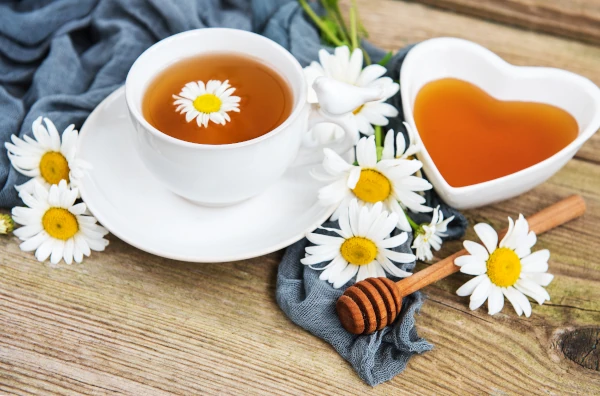
What does chamomile tea taste like?
Chamomile tea has a delicate and soothing flavour, often described as sweet and floral with a hint of apple-like undertones. When you take a sip, you may notice a subtle, almost honey-like sweetness, which is quite refreshing. The gentle taste makes it a popular choice for those looking to unwind and relax.
The tea is made from the dried flowers of the chamomile plant, giving it its unique flavour profile. This mild and aromatic taste is not overpowering, making it a perfect beverage for any time of day, especially before bed.
How should chamomile tea be prepared for the best taste?
To get the best flavour from your chamomile tea, you need to pay attention to the brewing process. The right water temperature, tea quantity, and steeping time are essential for extracting the optimal flavour.
Here’s a guide to help you understand how to brew chamomile tea properly:
| Brewing Method | Water Temperature | Tea Quantity | Steeping Duration |
|---|---|---|---|
| Hot Infusion | 93°C | 1 tsp | 5 minutes |
| Cold Infusion | Room Temperature | 1 tsp | 6-8 hours |
| Quick Steep | 93°C | 2 tsp | 3 minutes |
| Strong Brew | 93°C | 1.5 tsp | 7 minutes |
| Light Brew | 85°C | 1 tsp | 3 minutes |
| Iced Chamomile | 93°C | 2 tsp | 5 minutes (then cool) |
| Chamomile Latte | 93°C | 2 tsp | 5 minutes (with milk) |
Using this table, you can experiment with different brewing methods to find the one that suits your taste preferences. For a hot infusion, use water heated to around 93°C, a teaspoon of chamomile flowers, and let it steep for about five minutes.
If you prefer a cold drink, try a cold infusion by placing the tea in room temperature water and letting it steep for six to eight hours. Remember, the quality of water and fresh chamomile flowers also significantly affect the taste.
What are the health benefits of drinking chamomile tea?
Chamomile tea is not only delicious but also packed with health benefits. It’s been used for centuries as a natural remedy for various ailments.
- Promotes Sleep: Chamomile tea is known for its calming effects, making it an excellent choice for those who have trouble sleeping.
- Reduces Stress: Drinking chamomile tea can help reduce anxiety and stress levels, thanks to its soothing properties.
- Aids Digestion: It can also help with digestion, relieving symptoms like bloating and indigestion.
- Boosts Immunity: Chamomile contains antioxidants that may bolster your immune system.
- Skin Health: The tea’s anti-inflammatory properties can improve skin health and reduce irritations.
Enjoying a warm cup of chamomile tea can provide these benefits, enhancing your overall well-being.
How can chamomile tea be flavoured?
While chamomile tea tastes delightful on its own, you can enhance its flavour with a few simple additions.
- Honey: Adds a natural sweetness that complements the floral notes.
- Lemon: A squeeze of lemon juice adds a zesty twist.
- Mint: Fresh mint leaves provide a refreshing flavour.
- Cinnamon: A dash of cinnamon can give it a warm, spicy kick.
- Ginger: Fresh ginger slices add a bit of heat and depth.
Experiment with these flavours to find your perfect cup of chamomile tea. Each addition can transform the taste, making it a versatile drink.
Back in ancient Egypt, chamomile was highly valued for its medicinal properties. Egyptians used chamomile not just as a tea, but in various remedies. It was associated with the sun god Ra, believed to cure fever and other ailments.
They even used chamomile in embalming oils and cosmetics. This historical reverence for chamomile highlights its long-standing significance in natural healing.
I remember the first time I tried chamomile tea. It was a chilly evening, and I was looking for something to warm me up and help me unwind. A friend recommended chamomile tea, and I decided to give it a shot.
The subtle sweetness and calming aroma instantly put me at ease. Now, it’s a staple in my nightly routine, a comforting ritual to end the day on a relaxing note.
What are the different varieties of chamomile tea?
Chamomile tea isn’t just one thing; it’s a delightful herbal concoction made from various chamomile plants that grow in different parts of the world. We’re talking about German chamomile, Roman chamomile, and even Egyptian chamomile – all these fancy names for flowers in your cup.
Each type has its own quirks and qualities that make it stand out. And oh boy, does the origin matter! Where these plants are grown influences their flavours and properties, making each cuppa a unique experience.
German and Roman chamomile are the two popular heavyweights in the chamomile tea world. German chamomile, also known as Matricaria recutita, is commonly found in teas thanks to its sweet, apple-like flavour and wonderful calming properties.
Roman chamomile, or Chamaemelum nobile, on the other hand, has a slightly more bitter, earthy taste along with a similar relaxing effect.
What is the difference between German and Roman chamomile?
This is where tea enthusiasts start getting a bit snobby – for good reason.
German Chamomile:
- Sweet, apple-like flavour
- Commonly used in tea blends
- Tall, daisy-like flowers
- Known for strong sedative properties
- Often used in cosmetics and skincare
Roman Chamomile:
- Slightly bitter, earthy flavour
- Often used as a groundcover plant
- Short, daisy-like flowers
- Milder sedative properties compared to German chamomile
- Frequently used in essential oils for aromatherapy
In short, German chamomile is your go-to when you want a sweeter, more floral tea. Roman chamomile is great if you’re into more robust, earthy flavours.
How does the origin affect the flavour of chamomile tea?
If you thought all chamomile tea tasted the same, think again. The flavour is greatly influenced by where it’s grown. Soil, climate, and even the local farming methods can give each batch its own character.
- German chamomile from Eastern Europe: Typically sweeter with a more intense apple-like flavour.
- Roman chamomile from England: Slightly more bitter and robust due to the cooler climate.
- Egyptian chamomile: Known for its large, bright flower heads and a sweeter, more luxurious taste.
The origin not only affects the flavour but also the aroma and even the calming and medicinal properties. So, don’t judge a chamomile tea by its daisy; take a peek at its passport!
Are there any unique properties of Egyptian chamomile?
Absolutely, Egyptian chamomile is the royalty of chamomiles, and not just because it comes from the land of Pharaohs.
- Sweeter, honey-like flavour
- Large, golden flower heads
- Rich aroma that enhances relaxation
- Often considered to have stronger calming properties
Egyptian chamomile is often considered the crème de la crème of chamomile teas. Its flavour is usually richer and more nuanced, making it a favourite among those looking for the ultimate relaxing experience.
Back in ancient Egypt, chamomile was a favourite of the pharaohs and even used as an offering to the gods. Cleopatra herself was said to use chamomile in her beauty regime. Now, I’m not saying you’ll wake up with Cleopatra’s stunning looks if you sip on Egyptian chamomile, but it’s a nice thought to hold onto as you drift into a chamomile-induced nap.
Fancy a cup now?
How does the preparation method affect the taste of chamomile tea?
Chamomile tea, the golden elixir that’s synonymous with relaxation, can become either your best friend or a floral nemesis, depending on how you prepare it. You might think, “It’s just tea! How complicated can it be?”—famous last words, dear reader.
The taste of chamomile tea can transform dramatically based on factors like steeping time, water quality, temperature, storage, and ingredient combos. Let’s dive in and make sure you don’t end up sipping something that tastes like wet hay.
First up, steeping time. Ever noticed how chamomile tea can taste like a delicate flower garden, or like you’ve been chewing on bits of grass? That’s all down to how long you let it steep. Too short, and it’s weak and boring.
Too long, and it’s an invitation to Bitterness City. Ideally, you want to steep it for about 5 to 10 minutes.
And let’s not underestimate water quality. If your tap water tastes funky, guess what? So will your tea. Filtered water is the secret weapon here—it’s like giving your chamomile the red-carpet treatment. Trust me, the results are worth it.
Temperature matters too. Pouring boiling water over those delicate flowers can scald them faster than you can say “Tea Time.” Aim for a temperature of around 90°C. Yep, it’s a bit fiddly, but using water that’s just off the boil is the sweet spot.
Storing tea properly makes a difference. If you leave it hanging around in the open air or in a sunny spot, you’re basically waving goodbye to its flavour. Keep it in a cool, dark place, and your taste buds will thank you.
Finally, do some experimenting with ingredient combinations. Adding a splash of honey, a slice of lemon, or a pinch of mint can elevate that simple cup of chamomile into something extraordinary.
How long should chamomile tea be steeped?
Steeping chamomile tea is where you either make magic or mar it. Let’s break it down.
- 1 to 3 minutes: You’ll get a light, floral taste. Perfect if you’re a fan of subtlety.
- 5 to 7 minutes: This is the sweet spot. The flavour is balanced, aromatic, and relaxing.
- 10 minutes or more: Proceed with caution. The tea can become overpoweringly bitter.
Avoid letting it steep too long, unless you’ve got a thing for bitterness that rivals over-steeped coffee. Keep an eye on that timer, and you’re golden.
Does the quality of water affect the taste?
Absolutely, the quality of water can make or break your chamomile tea experience.
- Tap water: Can contain chlorine and various minerals that might alter the taste.
- Filtered water: Ideal for a clean, pure taste.
- Bottled spring water: Also a good option, as long as it isn’t mineral-heavy.
- Distilled water: Not recommended. It lacks the minerals that contribute to the overall flavour profile.
Using filtered or spring water can make your tea taste as if it’s been brewed by the tea gods themselves. Skip the tap unless you fancy your tea with a side of chlorinated or metallic nuances.
Can other ingredients enhance chamomile tea’s flavour?
Yes, and how! Adding complementary ingredients can turn an ordinary cup of chamomile tea into an extraordinary experience.
- Honey: Adds a touch of sweetness and balances the floral notes.
- Lemon: Introduces a zesty, citrusy kick.
- Mint: Freshens things up, giving a cool aftertaste.
- Lavender: Enhances the floral aspects.
- Ginger: Adds a spicy, warming element.
These additions aren’t just about taste. They can also bring extra health benefits, turning your cup of relaxation into a wellness powerhouse.
Back in the days of the Roman Empire, chamomile wasn’t just a soothing beverage. Roman soldiers used chamomile before going into battle. No, not to calm their nerves, but to ward off infections from wounds.
Imagine that! Sipping on the same tea that fierce Roman warriors trusted. It’s like your cup of chamomile tea is not just a drink, but a connection to historical resilience. And hey, if it was good enough for them, it’s certainly worth perfecting your brew, don’t you think?
What are common misconceptions about chamomile tea?
Chamomile tea often gets thrown into the list of misunderstood beverages, with myths floating around like leaves in a teapot. This cheerful little brew is more than just a nighttime elixir. Let’s take the lid off some burning misconceptions and get to the essence.
First off, chamomile tea doesn’t magically make you fall asleep. Sure, it’s often paraded as a sleep wonder, but it’s not a substitute for counting sheep.
Secondly, chamomile tea gets wrongly labelled as having caffeine. Spoiler alert: it doesn’t—more on that in a bit.
Thirdly, is it safe for pregnant women? It’s like one’s ability to hit high notes in the shower—it varies. Then, allergies. Some people believe everyone can sip chamomile tea without a hitch, but allergic reactions can happen.
Lastly, ever compared chamomile to other herbal teas? If you think it’s the same as every other herb-infused hot water, you’re in for a surprise!
To summarise, breaking down these myths helps you enjoy chamomile tea for what it really is.
Is chamomile tea safe for pregnant women?
Pregnancy often brings a list of ‘dos and don’ts’ longer than a child’s Christmas wish list. So, is chamomile tea on the naughty or nice side?
- It’s considered generally safe in moderate amounts.
- Some experts advise a bit of caution due to insufficient research.
- It may help with relaxation, which is beneficial.
- Large amounts could potentially cause uterine contractions.
- Always better to consult with a healthcare provider during pregnancy.
So, if you’re expecting, erring on the side of caution won’t hurt and always consult a professional. A small, comforting sip here and there is typically fine—just don’t go overboard.
Does chamomile tea contain caffeine?
One might think chamomile tea needs a bold “Caffeine-Free” sticker slapped on it. Unlike most of your morning brews and energy-boosters, chamomile is naturally sans-caffeine.
- Made from dried flowers, not tea leaves.
- Ideal for those avoiding caffeine.
- Perfect nighttime option without jitters.
- Supports relaxation without stimulating effects.
- Comparable to other herbal teas which are caffeine-free.
In short, it’s your go-to if you want to unwind without the risk of staying awake all night examining the cracks on the ceiling.
Are there any allergies associated with chamomile tea?
Thinking chamomile is all sunshine and rainbows? Not quite. Allergic reactions can indeed rain on your parade.
- More likely in those allergic to ragweed, daisies, marigolds, or chrysanthemums.
- Symptoms can include skin rashes, throat swellings, and difficulty breathing.
- Essential to start with small amounts if you’re a newbie.
- Always choose high-quality, uncontaminated sources.
- Consult your doctor if you have a history of severe allergies.
Although rare, being aware of potential allergies ensures you sip safely. Starting small is the way to go—in case you end up sounding more like a croaky frog than a content tea connoisseur.
In ancient Egypt, chamomile was used not just for its calming properties but also as part of religious ceremonies and beauty regimens. It was so valued that it was offered to their gods and kings.
Cleopatra, known for her incredible beauty, frequently bathed in a concoction of herbs, including chamomile, to maintain her youthful glow. So, next time you brew a cup, remember you’re partaking in a ritual that’s been treasured for millennia—only without the grand temples and scarab beetle jewellery.
Trust the ancients—they knew a thing or two about the finer stuff in life.
Can chamomile tea be mixed with other ingredients?
Sure thing, chamomile tea can definitely be mixed with other ingredients. You don’t have to be a mad scientist in a lab to create a delightful chamomile blend. Let’s dive into some combos that’ll make your taste buds do the cha-cha and boost your wellness game.
Adding ingredients like honey, lemon, mint, ginger and other herbal teas to chamomile can be more than just a taste experiment. Each brings something unique to the table—be it a new flavour dimension or added health benefits.
What ingredients pair well with chamomile tea?
When it comes to mix-and-match with chamomile tea, you’ve got plenty of options. Here’s the rundown on what pairs like a dream:
- Honey: Sweetness galore and a natural remedy for sore throats.
- Lemon: Zesty and tangy, perfect for a citrusy kick.
- Mint: Refreshing and cooling, adds a new layer of zest.
- Ginger: A warm, spicy twist that’s also good for digestion.
- Lavender: Floral and calming, pairs well if you like a more aromatic experience.
- Peppermint: Sharp and invigorating, excellent for a refreshing blend.
- Cinnamon: Warming spice that adds depth and warmth.
- Valerian root: Intensifies the calming properties of chamomile for sleep.
You’re not stuck with just one blend either. Mix and match these for a symphony of flavours and benefits. Plus, the fusion of these ingredients can help target specific wellness goals.
How does honey affect the flavour?
Adding honey to chamomile tea is like putting the cherry on top of your favourite dessert. It not only sweetens the tea but also:
- Balances bitterness: Chamomile can be a tad bitter for some; honey steps in to mellow it out.
- Enhances soothing properties: Honey is a natural soother; imagine doubling up with the calming effects of chamomile.
- Boosts antioxidants: Both honey and chamomile are rich in antioxidants, making for a health-boosting combo.
- Aids sore throats: Perfect for when you’re under the weather.
So, go ahead and add that golden drizzle of honey. Your taste buds—and your throat—will thank you.
Can chamomile tea be blended with other herbal teas?
Absolutely! Chamomile is like that easy-going friend who gets along with everyone. Here’s why blending chamomile with other herbal teas can be a brilliant idea:
- Peppermint tea: Refreshing and cooling.
- Rooibos tea: Adds a nutty, sweet flavour with extra antioxidants.
- Lemongrass tea: A citrusy zing that pairs nicely with chamomile’s smoothness.
- Hibiscus tea: Think of it as adding a fruity tartness.
- Elderflower tea: A hint of floral sweetness.
- Lemon Balm: Another relaxing herb that complements chamomile’s calming effects.
- Licorice root: Adds a natural sweetness with digestive benefits.
- Echinacea tea: Known for boosting the immune system, works well with chamomile if you’re fighting off a cold.
By blending chamomile with these herbal teas, you can optimise both flavour and health benefits. It’s a win-win.
In the early 1900s, British soldiers during World War I were introduced to all sorts of herbal remedies to combat stress and sleeplessness amidst the chaos. Chamomile, often paired with mint or honey, was a common go-to.
These blends helped the soldiers wind down after gruelling days, showing that the tradition of mixing chamomile with other herbs for calming effects has a long, storied past. So, next time you blend chamomile tea with honey or mint, you’re not just making a drink—you’re partaking in a century-old tradition of natural relaxation.
What is the best time to drink chamomile tea?
Alright, we all know chamomile tea is the soothing nectar of the gods, ideal for those nights when you’re wrestling with sleeplessness. But hold your horses—there’s more to chamomile than just the pre-snooze ritual. Timing can indeed influence the magic this floral elixir weaves.
Chamomile tea—a fragrant blend with a mild, apple-like flavour—brings tranquillity in a cup, and utilising it at the right moments can optimise its benefits. Picture sipping it after meals to aid digestion or during stressful moments to restore calm.
Making chamomile tea a daily tradition can enrich your life with a calming ritual. Plus, social settings with chamomile tea can foster a sense of community and relaxation. Let’s further break it down.
Is it best to drink chamomile tea before bed?
Yes, of course! If chamomile were a superhero, sleep would definitely be its secret identity. The best time to down a cup of chamomile tea is about 30 minutes before you hit the hay. It helps to transition your body and mind into a more relaxed state, perfect for ensuring a peaceful slumber.
Ideal moments before bedtime:
- Sip it about 30-45 minutes before you plan to go to sleep.
- Preferably after you’ve wrapped up blue light exposure. Yes, I’m talking about putting that mobile phone away!
- Avoid heavy meals before drinking; it works best on a lighter stomach.
- Maybe combine it with a bedtime story or meditation for ultimate relaxation.
- A warm, not boiling hot, cup of chamomile will do wonders.
The tea contains apigenin, an antioxidant that binds to receptors in the brain, promoting sedation. But hey, don’t just guzzle a gallon and hope for the best—a moderate amount is where the charm lies.
Can chamomile tea be consumed throughout the day?
Absolutely, without a shadow of a doubt. Chamomile isn’t a one-trick pony. This golden brew can be sipped at various times of the day. Think of it as your floral buddy in a cup, ready to de-stress, aid digestion, and even offer a moment of zen during frantic work hours.
Prime times to sip chamomile throughout the day:
- After meals to help digestion, particularly after lunch.
- During those pesky mid-afternoon slumps when you need a break.
- Whenever you face stressful moments—before that big meeting or presentation.
- As part of your morning ritual to start the day calm and centred.
- Anytime you feel uneasy or anxious. Your chamomile cavalry is always at the ready.
It’s caffeine-free, so you won’t be bouncing off the walls in the middle of the night. Plus, regular consumption can help in maintaining a balanced digestive system and a steady mood.
You guessed it—everything’s better when shared, and a pot of chamomile tea is no exception. While not the life of the party like a swanky cocktail, chamomile brings people together in subtle, meaningful ways. Sharing a pot of this soothing tea can offer a communal sense of calm and foster connections between friends and family.
Social perks of chamomile tea:
- Breaking the ice with new acquaintances over a calming brew.
- Creating a calming, relaxed atmosphere during social gatherings.
- It’s a thoughtful gesture—offering it shows you care about others’ wellbeing.
- Bonding over shared stories and experiences in a relaxed setting.
- Enhancing gatherings with a ritual that promotes overall wellness.
Imagine a family get-together, circle of friends, or even a casual tea date at a café, fostering genuine conversations over mugs of chamomile. This herb’s calming effect can mitigate social anxiety, helping everyone feel more at ease.
During the 18th century, a bunch of English herbalists were captivated by chamomile’s potential. One of them, Dr. Nicholas Culpeper, was so smitten he penned down chamomile’s multifaceted uses: from treating digestive issues to easing headaches.
This laid the groundwork for why today, tea enthusiasts and health aficionados alike see chamomile tea as more than just a beverage—it’s a trusty companion for life’s ups and downs.
By integrating chamomile tea into your daily routine, you’re not just sipping herbal goodness; you’re continuing a centuries-old tradition of holistic wellness.
Conclusion
As I reflect on the intricate world of chamomile tea, I am reminded of its captivating flavour profile, characterised by gentle sweetness and floral aromas, complemented by a hint of apple.
This soothing tea transcends mere taste; it offers an invitation to relaxation and wellness, making it a staple for those seeking natural remedies. With its various preparations, from soothing hot infusions to refreshing cold brews, we have the tools to elevate our tea-drinking experience.
The significance of understanding chamomile tea goes beyond enjoyment. Its potential health benefits—improving sleep quality, alleviating anxiety, and supporting digestion—underscore its value in our everyday lives.
However, as I’ve discovered, it’s essential to approach these benefits with knowledge, considering variations like German, Roman, and Egyptian chamomile that each contribute their unique characteristics based on their origins.
I encourage you to explore further—experiment with steeping times, choose high-quality water, and consider delightful additions like honey or mint. There is much to be unearthed in pairing chamomile with other ingredients or enjoying it during tranquil moments or social gatherings.
In the end, chamomile tea is not just a beverage; it’s a sensory experience entwined with cultural significance and personal ritual. As the poet William Wordsworth said, “The best part of beauty is that which no picture can express.”
I invite you to reflect on your relationship with chamomile tea and let its fragrant whispers enhance your life’s quiet moments. What will your next cup reveal?
Resources
- A Comprehensive Study of Therapeutic Applications of Chamomile
- The Antioxidant and Anti-inflammatory Properties of Chamomile and Its Constituents
- Anti-Inflammatory and Cancer-Preventive Potential of Chamomile
- Long-Term Chamomile Therapy of Generalized Anxiety Disorder: A Study Protocol for a Randomized, Double-Blind, Placebo-Controlled Trial
- Effects of chamomile (Matricaria chamomilla L.) on sleep: A systematic review
- Chamomile: A herbal medicine of the past with bright future


